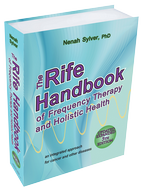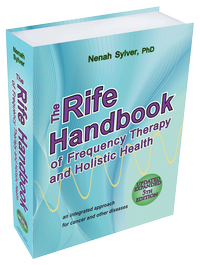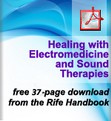Free Electromedicine Article
Healing with
Electromedicine
and Sound Therapies
The Rife Handbook
of Frequency Therapy
and Holistic Health 5th Edition
an integrated approach for cancer
and other diseases
by Nenah Sylver, PhD

Now available as a Hardcover
and in MOST formats!
as a printed/bound hardcover
as a Windows ![]() eBook
eBook
as a Mac  eBook
eBook
for some (not all) Tablets
for Android 
Introduction
In the 1960s, counterculture hippies were urging us to give peace a chance (great advice). To expedite that process, it was helpful to have “good vibrations”—considered so important that the Beach Boys wrote a catchy song with this title. It was easy to tell who had good vibes and who didn’t. An optimistic, considerate person was considered “high frequency,” while a pessimistic, disagreeable individual was “low frequency.” Not surprisingly, everyone wanted to be around the folks who had good vibes.
Colloquialism aside, saying that someone is “high frequency” is based on legitimate science. Every molecule, cell, living body, and object is comprised of energy that manifests as physical matter. Some of that energy is detectible as frequencies that belong to one or more radiation bands in the electromagnetic spectrum. And these frequencies correspond to biochemical and biological processes in the body.
In the healing arts, there are different ways to affect matter. With conventional medical care, the chemical, functional, and/or structural change in organs, glands, and other tissues are created either through biochemical manipulation (drugs) or physical manipulation (such as surgery). With electromedical therapies, healing is achieved by working with the electromagnetic radiation (emissions) and related energy fields that form, and are emitted by, physical matter. Basically, electromedical devices produce and focus specific frequencies that can be in the form of electromagnetic fields, electrical current, magnetism, visible light, heat, or other energy.
Although electromedicine is widely used in Europe, it is less known in the United States. Few people in developed countries would question the use of the ubiquitous transcutaneous electrical nerve stimulation (TENS) unit, which emits small amounts of electrical current to manage pain. And magnets embedded in the insoles of shoes, also for pain management, are now a regular item in consumer catalogues. But electricity and magnetism are still primarily used diagnostically-such as with the standard electrocardiogram (EKG or ECG) to assess the health of the heart, and with magnetic resonance imaging (MRI) to show the inside of the body. Most medical professionals, as well as the lay public, are not inclined to take advantage of less familiar electromedical devices because they don’t understand how they work. And those who do use the equipment might talk about “frequencies” or “energy” without fully understanding what these terms mean or knowing the science behind the technology.
Fortunately, receptivity to electromedicine is increasing. Health professionals are expanding their practice (and their success rate) with safe, holistic technologies. And the public is beginning to recognize and request electromedicine as an effective and valid treatment modality. In this review, I’ll explain what “frequency” and other terms mean as applied to the electromagnetic spectrum. I will explain electromagnetic energy in living systems, explore several types of electromedical modalities, and discuss the related modality of sound therapy.
from:
The Rife Handbook
of Frequency Therapy
and Holistic Health 5th Edition
an integrated approach for cancer
and other diseases
by Nenah Sylver, PhD




